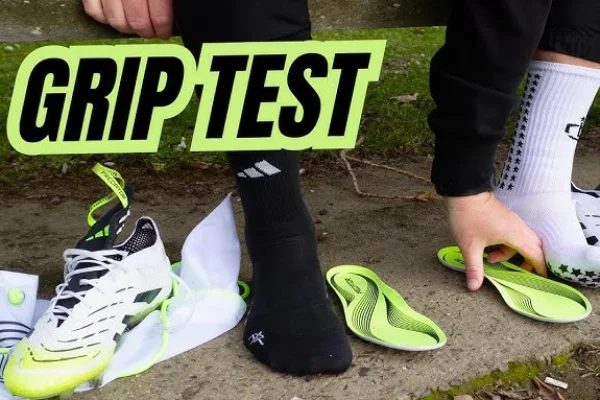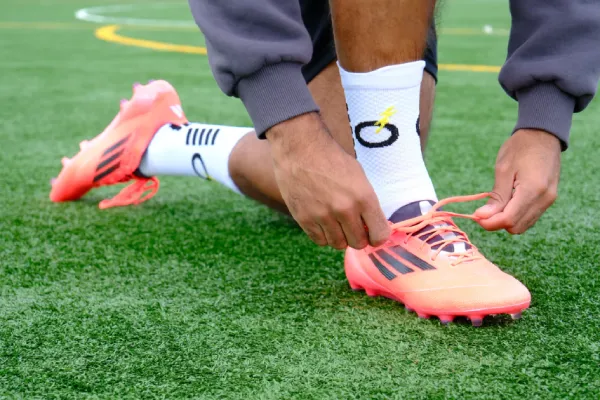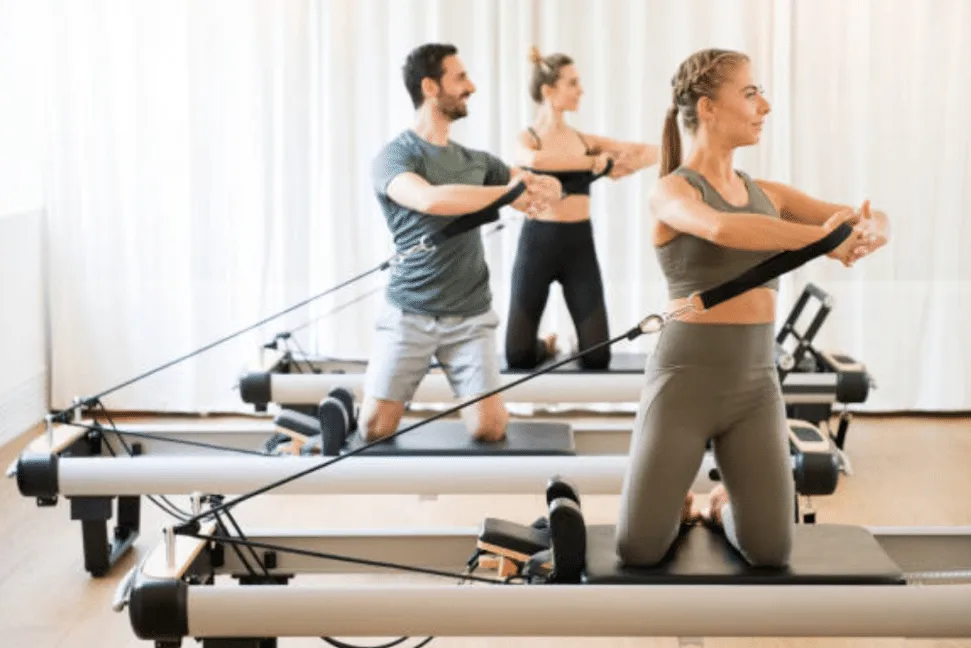Diagnose, fix, and prevent slip—fast.
Who this guide is for

- For Everyone: Quick Fix, Self-Check, Root Causes, Decision Table, Surface Matrix, FAQ.
- For Teams & Facilities (optional): An appendix with SOPs and purchasing specs. If you don’t run a studio, clinic, or team, you can skip the appendix.
Straight talk: most “slippy” grip socks come down to contamination, care mistakes, mismatched designs, or simple end-of-life wear. This page gives you a 30-second fix, a 3-step self-check, the 7 real causes (with fixes), and exactly when to repair vs. replace—plus deep-dives you can click into across our site.
Quick Fix (For Everyone)
Follow these three actions in order. Most readers stop here because traction returns.
- Clean → Dry → Retest. Wipe grip dots and a small patch of your floor; let both fully dry; test again on the same surface.
- Audit laundry. If you used fabric softener or any dryer heat, stop both. Wash cold/gentle, air-dry.
- Still slipping? Go to Fix or Replace (decision table), then use the Surface Matrix to match your sock pattern to your floor.
One-Minute Self-Check (For Everyone)

- Surface test: Try tile, wood, and mat. Note where traction is best—keep this in mind for the Surface Matrix (see Types of Grip Socks).
- Moisture check: If socks feel damp or slip after a few minutes, rotate pairs mid-session.
- Visual check: Hardened, cracked, or flattened dots usually mean replace (see table).
Root Causes → What to do (For Everyone)

Find your signal; apply the action.
Surface contamination (dust, oils, cleaner film)
- Signals: Slips on glossy floors; briefly improves after wiping.
- Action: Proper wash (cold, mild detergent), air-dry. Clean floor with a neutral, residue-free cleaner; avoid silicone “shine” products.
Deep-dive on care: How to Wash Grip Socks (site guide).
Care mistakes (softener residue & heat)
- Signals: Dots look shiny or feel hard; micro-cracks at edges; got worse after a dryer cycle.
- Action: Eliminate softeners/dryer sheets; air-dry. If dots are hardened/cracked/peeling, replace.
Moisture load (sweat & humidity)
- Signals: Fine at first, then slippery; socks feel damp; footprints linger.
- Action: Bring a backup pair; change mid-session; use breathable shoes/insoles; wash and fully dry between uses.
Deep-dive: Grip Socks Guide (Care & Buying Tips).
Fit/lockdown (inside a shoe)
- Signals: Great on mats barefoot, but foot slides inside the boot; heel lift during cuts.
- Action: Snug sizing; add a textured insole or thin sock-liner; re-lace for midfoot lock.
Design ↔ surface mismatch
- Signals: Works on rubber mats but not on tile (or the reverse).
- Action: Use the Surface Compatibility Matrix below to pick dot density/coverage for your floor.
End-of-life wear
- Signals: Large shiny/flat areas; missing dots; still slippery after proper cleaning and dry.
- Action: Replace and set a session target so worn pairs don’t reach risky settings.
Fix or Replace? (Decision Table · For Everyone)
| Situation | Do This | Why it Works |
|---|---|---|
| Contamination or recent softener use | Rewash cold (mild detergent), air-dry, retest | Removes films; preserves grip compound |
| Light dulling, dots intact | Clean floor + socks; try your best surface/shoe combo; retest | Restores interface; reduces shear |
| Dots hardened, cracked, or peeling | Replace | Heat/fatigue damage is not reversible |
| Wide areas flattened smooth | Replace | Wear exceeds design life |
| Clinical/sport need + any failure after retest | Replace | Safety over salvage |
Surface Compatibility Matrix (For Everyone)
| Primary surface | Typical risk | Recommended grip layout | Setup tips |
|---|---|---|---|
| Glossy tile/sealed wood | Cleaner film, low micro-texture | Higher dot density with wide coverage (forefoot + heel) | Neutral, residue-free cleaner; avoid silicone “shine” products |
| Textured rubber / studio mats | Over-bite/drag with bulky dots | Medium density with defined pods | Wipe mats; replace chalky/glazed mats |
| Sealed concrete | Dust; micro-abrasion | Medium–high coverage with durable compound | Dry-mop before sessions; store away from grit |
| Inside a shoe (sport) | In-boot shear | Snug knit + targeted external dots; focus on in-shoe friction | Add a textured insole; improve heel and midfoot lock |
| Clinical vinyl/hospital floors | Detergent/antiseptic residues | High coverage, thin compliant dots | Standardize one residue-free cleaner and stick to it |
Extra Traction Boosters (For Everyone)

- Floor care that matters: skip polishes or “gloss” products; use neutral cleaner + microfiber; plain-water rinse weekly.
- Foot prep: avoid lotions within 2 hours of use; manage thick, smooth callus with gentle filing; keep the inside dry by swapping to a fresh pair for the second half.
- In-shoe materials:
- Helps: textured fabric/perforated PU insoles; suede-like liners.
- Hurts: slick top-coated leather, glossy EVA, worn-smooth foam.
- Quick fix: add a thin textured sock-liner or change to a rougher insole topcloth.
- Safe “de-glaze” for dots: warm water + drop of mild dish soap; soft brush; rinse; air-dry. Avoid solvents/abrasives/heat.
FAQs
Why are my grip socks suddenly slippery?
The usual culprits are residue on the floor (detergent/polish film), laundry mistakes (fabric softener coating, tumble-dryer heat), moisture load (sweat/humidity), or end-of-life wear. Floor films from soaps/polishes reduce traction on tile/wood; softeners coat fibers and impair performance; brands explicitly warn not to tumble-dry; higher moisture raises skin–textile friction variability. Fix each factor first, then reassess.
How do I make grip socks grippy again (today)?
Reset the interface: (1) Wash cold, mild detergent, inside-out; no softener; air-dry. (2) Clean the test patch of floor with a neutral, residue-free cleaner; avoid silicone polishes. (3) If dots look “glazed”, do a gentle warm-water + tiny drop of dish soap scrub with a soft brush; air-dry. If dots are hardened/cracked/peeling, replace.
Can I tumble-dry grip socks or use fabric softener?
No to both if you care about traction and lifespan. Major manufacturers specify “do not tumble-dry / no fabric conditioner.” Heat can harden or crack grip compounds; softeners leave a hydrophobic film that diminishes moisture management and perceived grip.
Why do brand-new grip socks feel slippery on tile but fine on mats?
Two reasons: surface texture and residue. Polished/sealed tile has low micro-texture and is sensitive to cleaner/wax films, which create an invisible slick layer; textured mats mask this issue. Also, some brands advise washing before first wear to remove finishing residues. Clean the tile with a residue-free method and give the socks a first wash.
How long do grip socks last—and when should I replace them?
Lifespan varies by surface, mileage, and care. Replace when you see large shiny/flat areas, hardening/peeling grips, or when—on a clean, matched surface after proper washing—your “grip score” averages <3/5 across three sessions. Tracking sessions gives you a clear cost-per-safe-session and removes guesswork.
Team & Facility Toolkit

SOP (post this as a one-pager):
- Floors: neutral cleaner only; no polishes on training days.
- Laundry: cold/gentle; no softener/dryer sheets; air-dry.
- Acceptance test: new batches pass a 10-step stand–lunge–pivot check on your actual floor.
- Issuance: 2 pairs per staff; label A/B to rotate; pull any pair that fails.
- Incident note: record surface, cleaner used, sock age, and action taken.
Purchasing spec (to cut returns):
Grip coverage (heel + forefoot), compound durability, care label stating no tumble-dry / no softener, and batch ID for traceability. Outfitting a studio, team, or facility? We can match the grip layout to your floor. Ask for a sample kit and a 10-step acceptance test—OEM/ODM ready.
